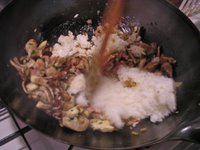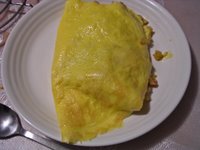
I know it is quite difficult to prepare this dish if you are not living in Japan.
Buri (Japanese yellowtail or amberjack, from the family of the jacks, jack mackerels and scads) is native to the northwest Pacific, from Japan to Hawaii.
This fish is a seasonal favourite in the colder months when the meat has higher fat content.
Teriyaki ("
Teri" for "
shiny" and "
Yaki" for "
grilled") sauce is another highlight of Japanese cuisine. It is not only used for fish, so if you can't find any "
Buri" it also works very well with chicken.
Serves 2-3- 4 fillets Buri
- salt
- 1-2 tablespoons vegetable oil
For the marinade
- 40ml soy sauce
- 40ml sake (or white wine)
For the Teriyaki sauce
- 40ml soy sauce
- 40ml mirin (a rice wine similar to sake, but with a lower alcohol content)
- 1/2 tablespoon honey
- a pinch of pepper
- 1 teaspoon ginger paste or grated ginger (optional)
Buri can have a very strong fishy taste, which doesn't fit the Japanese likings.
To get rid of the disturbing "fishiness", sprinkle both sides of the fillets with salt and leave them for 10 minutes. Meanwhile, put about one litter of water to boil.
Pour the boiling water over the salted fish (it will sart cooking a bit, this is normal), then rinse the fillets under tap water.

Prepare a marinade with equal amounts of soy sauce and sake (or white wine if you don't have any sake) and soak the Buri in this marinade for about 15 minutes.
After this, remove the fish from the marinade and pat them dry with kitchen paper.
Heat up a little bit of oil in a frying pan and fry the fillets until brown (about 2 minutes on each side).
Mix all the ingredients for the Teriyaki sauce (soy sauce, mirin, honey, pepper, ginger) and pour it over the fish. Let it simmer until the sauce has reduced and thickened (not more than 5 minutes otherwise the fish will become dry).
Serve with rice and slices of boiled
daikon (a type of white radish).
-----
Je n'ai pas trouvé l'équivalent Francais de ce poisson, le "
Buri". Selon la nomenclature latine il est
Seriola quinqueradiata, ou pour traduire littéralement de l'anglais, "queue jaune".
Ce plat est très apprécié par ici, surtout en période hivernale. La sauce
Teriyaki (
Teri pour "
brillant" et
Yaki pour "
grillé")
est souvent utilisée en cuisine Japonaise, et très bonne également avec du poulet.
Pour 2-3 personnes
- 4 fillets de Buri
- du sel
- un peu d'huile
Pour la marinade
- 40ml de sauce de soja
- 40ml de saké (à defaut, du vin blanc)
Pour la sauce Teriyaki
- 40ml de sauce de soja
- 40ml de mirin (un genre de saké à moindre teneur en alcohol)
- quelques tours de poivre
- 1 c. café de gingembre en tube ou rapé (pas essentiel mais c'est meilleur)
Pour se débarasser du goût "poissoneux" très prononcé du Buri, saupoudrer les deux côtés des fillets de sel, et les laisser pendant 10 minutes. Pendant ce temps, faire bouillir de l'eau (environ 1 littre).
Verser l'eau bouillante sur les fillets, qui vont légèrement cuire. Les rincer ensuite sous l'eau du robinet.
Mélanger saké (ou vin blanc) et sauce soja en quantités égales et laisser reposer le poisson dans cette marinade pendant un quart d'heure.
Au bout de ce temps, enlever les fillets de leur marinade et les sécher en les tapotant avec du papier de cuisine.
Chauffer un peu d'huile dans une poêle et faire rissoler les Buri jusqu'a ce qu'ils aient une belle couleur dorée (environ 2 minutes de chaque côté).
Mélanger tous les ingrédients de la sauce Teriyaki (sauce soja, mirin, miel, poivre, gingembre) et la verser sur le poisson.
Continuer la cuisson jusqu'à ce que la sauce ait reduit et soit assez épaisse (pas plus de 5 minutes).
Servir avec du riz et des tranches de
daikon bouillies.

















